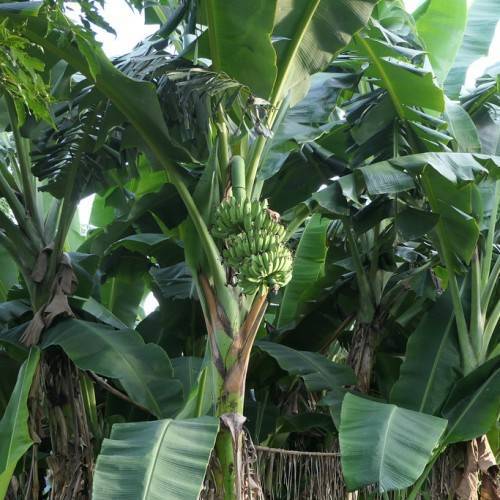
banana
Musa sp.
Cycle:
Herbaceous Perennial
Watering:
Average
Hardiness Zone:
3
Flowers:
Flowers In Summer
Sun:
Full sun only if soil kept moist, Part sun/part shade
Soil:
Acidic, Humus rich, Well-drained
Fruits:
Fruits In Autumn Ready In Fall
Leaf:
Yes
Growth Rate:
High
Maintenance:
Low
Care Level:
Medium
watering
Bee balm (Monarda didyma cvs.) should be watered regularly and heavily for best performance. Water when the top inch of soil is dry, approximately once-twice per week. Waterings should be deep and thorough, allowing moisture to penetrate to the plant's roots. Take care not to overwater, as this can lead to root rot and other health problems. Be sure to test the soil to determine if the plant needs more or less watering, as different environmental factors can affect the amount of water needed to keep the bee balm healthy.
sunlight
Bee balm plants prefer full sun and grow best in locations that receive at least 6 to 8 hours of direct sunlight per day. In areas that experience hotter temperatures and strong sunlight, such as the South and Southwest U.S., it’s best to plant bee balm in a spot that gets morning sun and some afternoon shade. In cooler climates or those with foggy summer days, bee balm will enjoy full sun all day long.
pruning
Bee balm is best pruned in late summer or early fall. Pruning should be done when the plant is done flowering and has finished producing seed. For most varieties of bee balm, it is usually best to reduce the height of the plant by 1-third to 1-half. All dead, diseased or damaged stems should be removed and thinning should be done to allow better air circulation throughout the plant. Pruning will help promote new growth and should be done with a clean pair of garden scissors or a sharp knife.
Propagation
Season
Hardiness Map
FAQ
Are bananas considered berries?
No, bananas are not considered berries. Botanically speaking, all berries are fruits that have multiple seeds on the inside of a fleshy layer (like a blueberry or raspberry). Bananas have an outer peel with a solitary seed. Therefore, technically speaking, bananas are not considered berries.
Should I choose to plant banana seeds or pups?
Which option you should choose really depends on your individual needs and goals. Planting banana seeds will result in a longer wait time for the fruits to mature but also the potential for greater diversity among your crop. Planting banana pups will result in quicker results but potentially less diversity. If you're looking for a quick harvest, banana pups may be the better option for you, but if you're looking for a greater payoff in the long term, banana seeds would be more appropriate.
Does soil pH play a role in banana growth?
Yes, soil pH plays an important role in banana growth. Bananas prefer a soil pH between 5.0 and 6.5, although some varieties can tolerate slightly more alkaline soils. If the soil pH is too high or too low, the nutrients in the soil will not be available to the banana plants and they will not be able to grow healthily. Additionally, bananas are particularly sensitive to aluminum toxicity, which is common in soils with a pH above 6.5, so soils with higher pH levels should be avoided.
Are there benefits to mulching banana plants?
Yes, mulching banana plants can bring a variety of benefits. It can help to prevent soil compaction, retain moisture, deter weeds, insulate the roots, control soil temperature, and introduce beneficial organisms to the soil. In addition, some organic mulches can add nutrition to the soil, such as aged compost. Mulching also improves the aesthetics of your banana plants’ environment with a variety of colors and textures, making them more visually attractive.
Is it accurate that bananas are high in potassium?
Yes, it is accurate that bananas are high in potassium. Bananas are an excellent source of potassium and are known as one of the best sources of dietary potassium. A single large banana provides more than 400 milligrams of potassium which is nearly 11% of the daily recommended amount. Additionally, bananas contain essential minerals such as magnesium, calcium, and phosphorous, as well as a variety of vitamins like vitamins A, C, and B6.
Is banana farming environmentally friendly?
Yes, banana farming can be environmentally friendly when done correctly. Sustainable farming practices help reduce the use of artificial irrigation, pesticides, and fertilizers that can damage the environment and water resources. By using natural methods of pest and weed control, sustainable farms are also able to reduce their carbon emissions. Renewable energy sources like solar power and biogas can also be used by banana farmers to reduce their environmental impact. With careful management and the right resources, banana farming can be a net benefit to the environment.
Is it possible to grow banana plants indoors?
Yes, it is possible to grow banana plants indoors. Banana plants can be successfully grown in containers with a large soil volume of at least 15 gallons. Keeping them in an area with ample light such as windowsill, greenhouse or conservatory is ideal. Temperatures should generally not drop below 55-60°F and they should be watered regularly, being sure not to let the soil become water-logged. Banana plants typically do not fruit indoors due to lack of pollination, but can still provide a decorative touch with their large leaves.
Can bananas be grown in cold climates?
Unfortunately, bananas cannot be grown in cold climates, as they require warm temperatures and an abundance of humidity to survive and produce fruit. Bananas thrive in tropical and subtropical regions where temperatures are more consistent and humidity levels remain high throughout the year. Growing bananas in colder climates is very rare and difficult to achieve without the use of greenhouses or other temperature-regulating structures.
